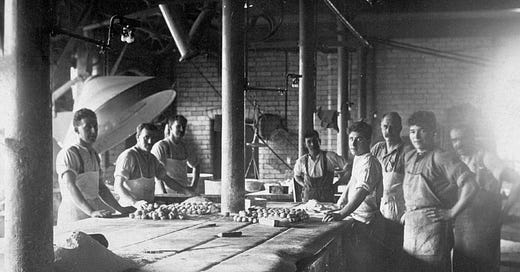The murder of Urban Stanger
When baker Urban Stanger vanished in 1881, it created a mystery that intrigued the country - and saw a private detective try, and fail, to solve the case
Urban Napoleon Stanger was the wonderfully named baker who catered for a poor community in the alleys and lanes of Shoreditch. Part of London’s German community, he had a close circle of expat friends. On 1 August 1869, he married a German woman, Elizabeth Gallon, at St Leonard’s Shoreditch, and one of their German friends, another baker named Franz Felix Stumm, was one of the marriage witnesses.
Edwardian bakers. Urban Stanger worked as a baker, albeit on a smaller scale than these men, but was seen as a financial success story
Stanger was born in 1845 in Kreuznach, Germany, but he made London his home, becoming naturalised in 1877. At this time, he was living in Cable Street, but he then took on a bakery at 134 Lever Street, Islington. This was part of a working-class area where there was little money, and it was viewed with fear and distrust by more wealthy Londoners: one press account described it as a ‘poor, obscure part of London’ with the bakery being ‘in a narrow thoroughfare in one of the poorest parts of the north-east of London’. (Cardiff Times, 7 October 1882). Yet Stanger did well here, and in fact was viewed as a success story for the area. He did his shop up, proudly displaying his name on the shopfront, and was able to amass savings.
Life was therefore tolerable for him. He had assistants to help him, and when he wanted a break, his friend Franz Stumm, who was also a baker, would come and help him. The census of 1881 records both men in London: Stanger at Lever Street, where he employed three men; and Stumm at St John Street in Clerkenwell, where he was working in his own shop, helped by a single young assistant.
The entry for Urban and Elizabeth Stanger in the 1881 census (TNA/TheGenealogist)
The 1881 census suggests a calm community, and strong friendships in that community, with two friends running their own bakeries, both living with their wives (Felix had married Englishwoman Alice Knight in 1878), and settled. By the end of the year, however, everything had changed.
On the evening of 12 November 1881, Urban Stanger disappeared. He was never seen again. He had been seen at around midnight that night, but then simply vanished. Things then started to get decidedly odd. Franz and Alice Stumm moved into the Lever Street bakery. Initially, Franz said he was just helping out, but then he removed Urban Stanger’s named from the shopfront, and replaced it with his own: ‘FF Stumm’. They didn’t look for Stanger; they didn’t seem worried about him. Franz simply moved in and assumed that nobody would care.
And what of Elizabeth Stanger, Urban’s wife? She continued to live at Lever Street, even helping out behind the bakery counter. In July 1882, nearly a year after Urban’s disappearance, he was legally assumed dead, and his will proved. A condition in his will stated that Elizabeth would only get his property if she never married or cohabited with a man again. At around this time, Elizabeth also disappeared - only to be located elsewhere in London in October.
At this point, Paddington private detective, and fellow German expat Wendel Scherer (who readers of this substack will recall reading about last week) issued a number of adverts and handbills:
“£50 reward. Mysteriously disappeared, since the early part of November last, from his residence, 136 Lever Street, City Road, Urban Napoleon Stanger, master baker…Any person who will give information leading to his discovery will receive the above reward. Wendel Scherer, private inquiry agent.”
Nobody came forward. But now, creditors started asking Stumm for money, and bankruptcy proceedings were issued. It was discovered that Stumm had spent every penny in Stanger’s bank account. The fascia of the baker’s was again painted over, removing Stumm’s name.
Now he suddenly claimed that he had a mortgage deed for the Lever Street shop, and approached one of the executors of Stanger’s will, a local flour factor, demanding £1,500 from Stanger’s estate. He was then allowed the shop back, and Alice Stumm moved back in to manage it.
It was then found that Stumm had forged the deed document, and he was duly charged with forgery and conspiracy. He was not the only one charged: Elizabeth Stanger was charged alongside him. In November 1882, Franz Felix Stumm was convicted of forgery, and sentenced to ten years in prison. He served his sentence at Pentonville and Chatham, and was released in July 1890, after serving nearly eight years. Elizabeth Stanger was convicted in February 1883, and sentenced to a year’s imprisonment with hard labour, which she served at Westminster Prison.
The description of Stumm, with his hairy chest and scars, from the Habitual Criminals Register (MEPO6, TNA/TheGenealogist)
It seems that the Stumms, working with Elizabeth Stanger, murdered Urban Stanger for his money. His body was never found, and so they could not be charged with that offence, but they were charged with the related offences, everybody knowing full well what had really happened, but being unable to prove it. Not even the private detective, Wendel Scherer, could prove it: but by issuing his handbills and adverts, he made clear to the offenders that Urban’s disappearance would not be easily forgotten.






